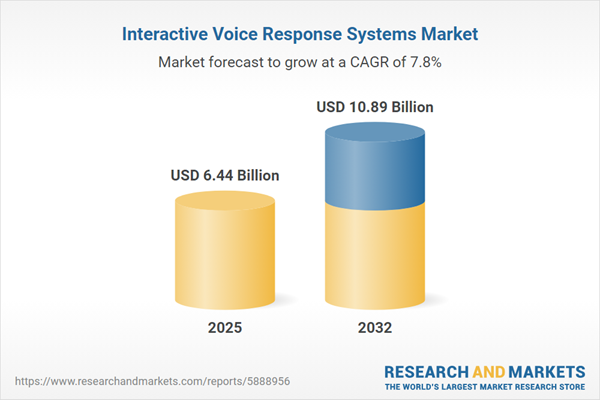Speak directly to the analyst to clarify any post sales queries you may have.
Interactive Voice Response Systems (IVR) are reshaping how enterprises engage with customers and optimize their operational workflows. As organizations drive digital transformation, IVR solutions are key to delivering streamlined interactions, regulatory alignment, and improved business responsiveness in dynamic commercial environments.
Market Snapshot: Interactive Voice Response Systems Market
The Interactive Voice Response Systems Market is demonstrating robust global growth, currently valued at USD 5.96 billion, with strong projections for further advancement. Market expansion is powered by enterprise investments in automation and digital communications infrastructure, addressing complex IT requirements while supporting service quality. Enhanced digital ecosystems and mounting operational demands are rapidly moving organizations toward sophisticated IVR adoption across established and growing regions, solidifying IVR’s position in the enterprise technology landscape.
Scope & Segmentation of the Interactive Voice Response Systems Market
- Component: Modern IVR platforms combine hardware and software capable of real-time analytics, advanced call routing, integrated speech recognition, and comprehensive reporting. These solutions are built to handle high-volume business activity and connect with current IT systems.
- Application: IVR technology enables call management, customer service automation, billing, order processing, and survey distribution. Automating such tasks increases consistency and productivity while allowing employees to dedicate more time to complex business priorities.
- Deployment Mode: Organizations can deploy IVR through private, public, managed cloud, hybrid, or on-premise approaches. Cloud and hybrid strategies allow scaling and adapting resources efficiently, matching fluctuating operational needs and regulatory environments.
- Organization Size: IVR solutions scale effectively for small, mid-sized, and large enterprises. Customization options help organizations of varied complexity and size meet their individual needs and optimize their workflows.
- End User: Sectors leveraging IVR include banking, financial services, government, healthcare, retail, and telecommunications. Each industry benefits from automation, information security, and tailored compliance support embedded in solutions.
- Geography: Adoption rates are highest in regions such as the Americas, Europe, Middle East & Africa, and Asia-Pacific. Growth is especially evident in countries like the United States, Canada, United Kingdom, Germany, China, India, and Japan, with increasing interest in emerging digital markets across Latin America and Africa.
- Covered Companies: Major solution providers include Cisco Systems, Avaya, NICE, Five9, Nuance Communications, Twilio, Alvaria, Vonage Holdings, 8x8, and Mitel Networks Corporation. A competitive provider landscape is spurring innovation and expanding deployment opportunities across sectors.
Key Takeaways for Senior Decision-Makers
- AI and machine learning are transforming IVR platforms by enabling intelligent automation, reducing manual intervention, and driving operational efficiency.
- Omnichannel integration supports unified customer experiences across voice, web, mobile, and social channels, centralizing management of client interactions.
- Cloud-native and hybrid environments increase organizational flexibility, supporting stringent security and compliance efforts during expansion.
- Enhanced authentication and access controls protect sensitive customer and business data, assisting organizations in navigating diverse regulatory landscapes.
- Customizable IVR solutions empower rapid operational automation and support fast adaptation to new regulations or evolving market requirements.
Tariff Impact: Navigating Cost Structures and Supply Chains
Recent updates to U.S. tariff regulations are influencing IVR hardware procurement strategies. In response, organizations are diversifying sourcing and strengthening regional supplier networks. These steps help manage costs and reinforce resilience in supply chains, ensuring stability despite global trade shifts.
Methodology & Data Sources
This report leverages in-depth secondary research, direct input from industry specialists, and robust quantitative and qualitative modeling to deliver a reliable, multi-faceted analysis of trends influencing the Interactive Voice Response Systems Market.
Why This Interactive Voice Response Systems Report Matters
- Enables senior leaders to align technology investments and regulatory approaches with evolving enterprise and industry requirements.
- Clarifies technology selection considerations and operational risk factors for organizations of any size, supporting more robust digital transformation planning.
- Highlights deployment strategies and scalability needs, guiding effective IVR adoption tailored to sector-specific demands and anticipated growth.
Conclusion: IVR Market Outlook
IVR solutions play a strategic role in elevating customer experience, fostering operational agility, and achieving regulatory objectives. Continued investment in advanced IVR capabilities is vital as organizations adapt to the evolving business landscape.
Additional Product Information:
- Purchase of this report includes 1 year online access with quarterly updates.
- This report can be updated on request. Please contact our Customer Experience team using the Ask a Question widget on our website.
Table of Contents
3. Executive Summary
4. Market Overview
7. Cumulative Impact of Artificial Intelligence 2025
Companies Mentioned
The companies profiled in this Interactive Voice Response Systems market report include:- Cisco Systems, Inc.
- Avaya Inc.
- NICE Ltd.
- Five9, Inc.
- Nuance Communications, Inc.
- Twilio Inc.
- Alvaria Inc.
- Vonage Holdings Corp.
- 8x8, Inc.
- Mitel Networks Corporation
Table Information
| Report Attribute | Details |
|---|---|
| No. of Pages | 182 |
| Published | November 2025 |
| Forecast Period | 2025 - 2032 |
| Estimated Market Value ( USD | $ 6.44 Billion |
| Forecasted Market Value ( USD | $ 10.89 Billion |
| Compound Annual Growth Rate | 7.8% |
| Regions Covered | Global |
| No. of Companies Mentioned | 11 |









